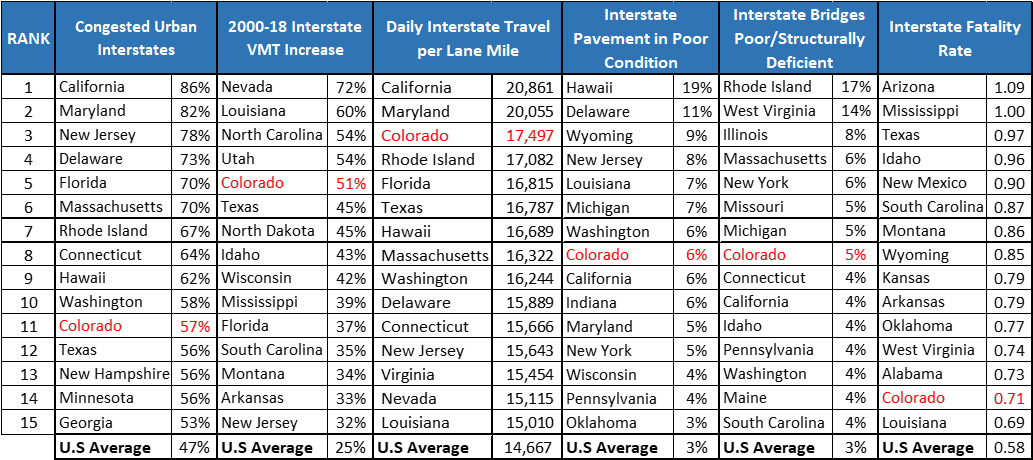FOR IMMEDIATE RELEASE
Thursday, July 23, 2020
Contact:
Rocky Moretti (202) 262-0714
Carolyn Bonifas Kelly (703) 801-9212
Contact TRIP spokespersons above to arrange interviews via phone, Zoom, Skype or FaceTime.
COLORADO INTERSTATE HIGHWAY SYSTEM’S CONGESTION, TRAVEL VOLUME, ROAD AND BRIDGE DETERIORATION, AND FATALITIES AMONG HIGHEST IN U.S. ACCORDING TO NEW TRIP REPORT
Denver, CO – The rate of congestion, travel volume, road and bridge deterioration and fatalities on Colorado’s Interstate Highway System are among the highest in the nation, according to a new report released today by TRIP, a national transportation research nonprofit. The report, Restoring Colorado’s Interstate Highway System: Meeting Colorado’s Transportation Needs with a Reliable, Safe & Well-Maintained National Highway Network, looks at the use, condition and benefits of Colorado’s Interstate system.
According to TRIP’s report, from 2000 to 2018, vehicle travel on Colorado’s Interstates has increased at a rate 17 times faster than the rate at which new lane capacity has been added. As a result, Colorado’s Interstates are the third busiest and the eleventh most congested in the U.S. The tremendous use on the system has also led to increased deterioration on Colorado’s Interstate roads and bridges, with the share of both Interstate pavement in poor and bridges in poor/structurally deficient condition in Colorado the eighth highest in the U.S. And, while the fatality rate on the state’s Interstate system is the 14th highest in the nation, travel on Colorado’s Interstate highways is nearly twice as safe as travel on all other roads in the state.
The chart below ranks states whose Interstate systems are the most congested, have experienced the greatest increase in vehicle miles of travel (VMT) since 2000, carry the greatest number of vehicles per lane mile, have the largest share of pavement in poor condition and bridges in poor/structurally deficient condition, and have the highest fatality rate.

“Colorado is in the midst of a slowly unfolding unquiet crisis – our transportation system is now under pressure from all sides: growing usage, age, antiquated financing and expensive inputs. As a result, Colorado is experiencing increases in congestion and further roadway degradation,” said Henry Sobanet and Ben Stein, Terry J. Stevinson Fellows with Colorado-based Common Sense Institute. Sobanet and Stein recently authored a new study on Colorado transportation, A Path Forward: A Common Sense Strategy for the Continued Viability of Colorado’s Transportation Network.
Colorado’s Interstate Highways are among the most critical links in the state’s transportation system and a vital part of Colorado’s transportation network. According to the TRIP report, while Colorado’s Interstate accounts for just two percent of all roadway lane miles in the state, it carries 27 percent of the state’s vehicle travel. But that system is become increasingly congested. In fact, travel on Colorado’s Interstate highways is increasing at a rate 17 times faster than the rate at which new lane capacity is being added. From 2000 to 2018, vehicle travel on Colorado’s Interstate highways increased 51 percent – the fifth fastest rate of growth in the nation. From 2000 to 2018, lane miles of Interstates in Colorado increased just three percent, from 4,043 to 4,165 miles. As a result, 57 percent of Colorado’s Urban Interstates are congested, the eleventh highest rate in the nation.
“Despite a number of attempts, addressing our transportation infrastructure remains one of the most pressing problems for Coloradans,” said Tony Milo, executive director, Colorado Contractors Association. “With each passing year, solving the problem becomes increasingly expensive and more challenging. We simply can’t afford to ‘kick the can down the road’ any longer.”
TRIP’s report finds that while pavement smoothness on most segments of the U.S. Interstate system is acceptable, the crumbling foundations of most highway segments need to be reconstructed, and that continued resurfacing rather than addressing underlying foundational issues provides diminishing returns and results in shorter periods of pavement smoothness. Pavements on six percent of Colorado’s Interstate highways are in poor condition, and five percent of Interstate bridges are rated in poor/structurally deficient condition. The levels of both pavement deterioration and bridge deterioration on Colorado’s Interstate system are the eighth highest in the nation. Nine percent of Colorado’s Interstate bridges are in need of repair or replacement, and 48 percent of its Interstate brides are 50 years or older.
The TRIP Report does find some good news based on additional safety features. The design of the Interstate – which includes a separation from other roads and rail lines, a minimum of four lanes, paved shoulders and median barriers – makes Colorado’s Interstates nearly twice as safe to travel on as all other roadways. The fatality rate per 100 million vehicle miles of travel on Colorado’s Interstate in 2018 was 0.71 – the 14th highest in the U.S.- compared to 1.34 on the state’s non-Interstate routes. TRIP estimates that additional safety features on Colorado’s Interstate Highway System saved 99 lives in 2018.
Sobanet, Stein and Milo agreed, the benefits to investing in infrastructure now goes beyond Colorado’s highways. “We can build our way out of a recession,” said Milo. “Investment in infrastructure is quite literally the road to economic recovery.”
Sobanet and Stein’s report also note that, “While the impact of COVID-19 and the response to contain it is currently ongoing, we believe the transportation issues that long-preceded the pandemic remain important to address. This is because it remains more likely than not that transportation investments will not only serve the future economic needs of our state, but also contribute to its near-term recovery.”
“The long-term vision that helped establish the current Interstate system nearly 65 years ago is needed again today,” said Dave Kearby, TRIP’s executive director. “In order to rebuild the nation’s economy, maintain personal and commercial mobility, and improve quality of life, adequate transportation investment and a sustainable, long-term funding source for the federal surface transportation program must remain a priority.”